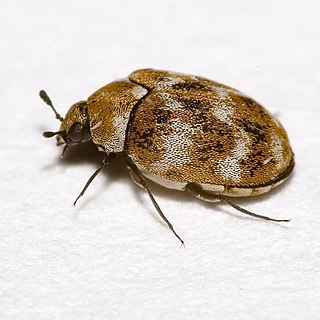
Dermestidae are a family of Coleoptera that are commonly referred to as skin beetles. Other common names include larder beetle, hide or leather beetles, carpet beetles, and khapra beetles. There are over 1,800 species described.

The khapra beetle, also called cabinet beetle, which originated in South Asia, is one of the world's most destructive pests of grain products and seeds. It is considered one of the 100 worst invasive species in the world. Infestations are difficult to control because of the insect's ability to survive without food for long periods, its preference for dry conditions and low-moisture food, and its resistance to many insecticides. There is a federal quarantine restricting the importation of rice into the U.S. from countries with known infestations of the beetle. Khapra beetle infestation can spoil otherwise valuable trade goods and threaten significant economic losses if introduced to a new area. Handling or consuming contaminated grain and seed products can lead to health issues such as skin irritation and gastrointestinal distress.

Anthrenus is a genus of beetles in the Dermestidae family, skin beetles. One of several genera of carpet beetles, Anthrenus was historically placed in a subfamily Anthreninae, though presently included in the Megatominae. The genus Neoanthrenus is closely related.

Trogoderma is a genus of beetles in the family Dermestidae, the skin beetles. There are about 135 species worldwide.

Megatominae is a subfamily of the beetle family Dermestidae. This subfamily contains several of the most well-known household and stored-product pest beetles, in the genera Anthrenus and Trogoderma.

Reesa is a monotypic genus of beetles in the family Dermestidae, the skin beetles. The sole species is Reesa vespulae. This beetle is native to the Nearctic, but today it can be found nearly worldwide; it is easily introduced to new areas.

Trogoderma inclusum, the larger cabinet beetle, is a species of carpet beetle in the family Dermestidae. It is found in Africa, Europe and Northern Asia, North America, Oceania, and Southern Asia.

Trogoderma serraticorne is a species of carpet beetle in the family Dermestidae, formerly known as Trogoderma anthrenoides.
Dearthrus is a genus of carpet beetles in the family Dermestidae local to North America. There are at least two described species in Dearthrus.

The Megatomini are a tribe of insects in the family Dermestidae.
Ranthenus is a subgenus of the genus Anthrenus of the subfamily Megatominae within the family of skin beetles. Species of subgenus are present only in Asia and Turkey. Subgenus is distinguished by antennae with 4 segments.
Setapeacockia is a subgenus of the genus Anthrenus of the subfamily Megatominae within the family of skin beetles.

Peacockia is a subgenus of the genus Anthrenus of the subfamily Megatominae within the family of skin beetles. Only one African species is currently described.

Solskinus is a subgenus of the genus Anthrenus of the subfamily Megatominae within the family of skin beetles. Subgenus is distinguished by antennae with 7 segments.

Nathrenus is a subgenus of the genus Anthrenus of the subfamily Megatominae within the family of skin beetles. The most well-known species from the subgenus, varied carpet beetle, is distributed in most parts of the world, whereas the vast majority of other species are only present in regions of Africa and Asia.

Anthrenus is a subgenus of the genus Anthrenus of the subfamily Megatominae within the family of skin beetles.

Anthrenus pimpinellae complex is a group of closely related species from subgenus Anthrenus. Most species that currently belong to the group were previously assigned as subspecies of Anthrenus pimpinellae.

Trogoderma angustum is a species of beetle in the family Dermestidae native to South America. It has been introduced to several regions including Europe, Asia, United States, New Zealand, and possibly Congo.
Anthrenus (Anthrenus) ethiopicus is a species of carpet beetle found in Ethiopia, Kenya, and South Africa.
Anthrenus (Anthrenus) kenyaensis is a species of carpet beetle found in Kenya, Namibia, and Tanzania.















